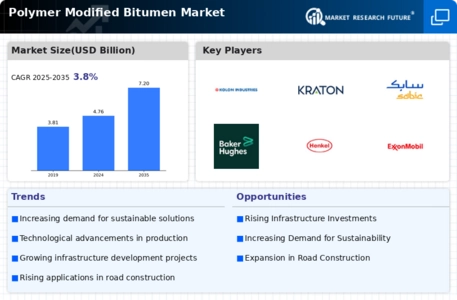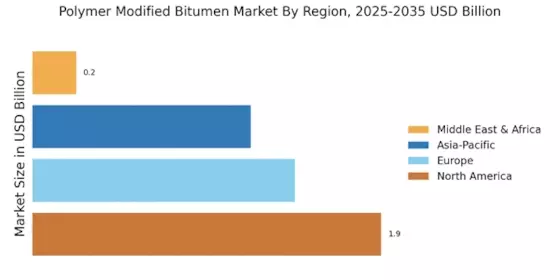Government Infrastructure Investments
Government investments in infrastructure development are significantly influencing the Polymer Modified Bitumen Market. Many countries are prioritizing the enhancement of their transportation networks, which includes the construction and rehabilitation of roads, highways, and airports. These initiatives often emphasize the use of advanced materials, such as polymer modified bitumen, to ensure longevity and performance. For instance, recent reports suggest that several nations have allocated substantial budgets for infrastructure projects, with a notable increase in funding for road construction. This trend is expected to bolster the demand for polymer modified bitumen, as it aligns with the goals of improving road quality and safety.
Environmental Regulations and Standards
The Polymer Modified Bitumen Market is also shaped by stringent environmental regulations and standards. Governments are increasingly mandating the use of sustainable materials in construction, which has led to a growing preference for polymer modified bitumen. This material not only enhances the performance of asphalt but also contributes to reducing the environmental impact of road construction. The incorporation of recycled materials in polymer modified bitumen formulations is becoming more common, aligning with global sustainability goals. As regulations tighten, the market is likely to see a shift towards more eco-friendly practices, further driving the adoption of polymer modified bitumen in various applications.
Growing Urbanization and Traffic Volume
The Polymer Modified Bitumen Market is significantly impacted by the trends of growing urbanization and increasing traffic volume. As populations migrate towards urban centers, the demand for efficient transportation systems escalates. This urban expansion necessitates the construction of new roads and the upgrading of existing ones, where polymer modified bitumen is favored for its durability and performance. The rising number of vehicles on the road further exacerbates the need for robust road surfaces that can endure higher loads and frequent use. Market analyses indicate that the demand for polymer modified bitumen is likely to rise in tandem with urban development, making it a critical component in future infrastructure projects.
Rising Demand for Durable Road Surfaces
The Polymer Modified Bitumen Market is experiencing a surge in demand for durable road surfaces. This trend is largely driven by the increasing need for long-lasting infrastructure that can withstand heavy traffic and adverse weather conditions. As urbanization accelerates, the pressure on road networks intensifies, leading to a preference for materials that offer enhanced performance. Polymer modified bitumen, known for its superior elasticity and resistance to deformation, is becoming the material of choice for road construction and maintenance. Recent data indicates that the market for polymer modified bitumen is projected to grow at a compound annual growth rate of approximately 5.2% over the next five years, reflecting the industry's response to these evolving demands.
Technological Innovations in Material Science
Technological innovations in material science are propelling advancements in the Polymer Modified Bitumen Market. Research and development efforts are focused on enhancing the properties of polymer modified bitumen, leading to improved performance characteristics such as increased resistance to aging and better adhesion. These innovations are crucial as they address the challenges posed by climate change and the need for more resilient infrastructure. The introduction of new polymer blends and additives is expected to expand the application range of modified bitumen, making it suitable for diverse environments. As these technologies evolve, they are likely to attract more investment and interest in the polymer modified bitumen sector.


















Leave a Comment